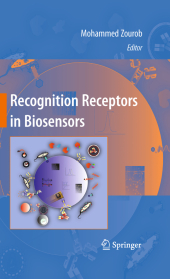 Neuerscheinungen 2016Stand: 2020-02-01 |
Schnellsuche
ISBN/Stichwort/Autor
|
Herderstraße 10
10625 Berlin
Tel.: 030 315 714 16
Fax 030 315 714 14
info@buchspektrum.de |

Mohammed Zourob
Recognition Receptors in Biosensors
Herausgegeben von Zourob, Mohammed
Softcover reprint of the original 1st ed. 2010. 2016. xvi, 863 S. 75 Tabellen. 235 mm
Verlag/Jahr: SPRINGER, BERLIN; SPRINGER NEW YORK; SPRINGER 2016
ISBN: 1-493-93940-8 (1493939408)
Neue ISBN: 978-1-493-93940-4 (9781493939404)
Preis und Lieferzeit: Bitte klicken
This book presents a significant and up-to-date review of the various recognition receptors, their immobilization, and an overview of the used surface characterization techniques. It includes more than 150 illustrations that help explain the ideas presented.
Recognition receptors play a key role in the successful implementation of chemical and biosensors. Molecular recognition refers to non-covalent speci?c binding between molecules, one of which is typically a macromolecule or a molecular assembly, and the other is the target molecule (ligand or analyte). Biomolecular recognition is typically driven by many weak interactions such as hydrogen bo- ing, metal coordination, hydrophobic forces, van der Waals forces, pi-pi interactions and electrostatic interaction (due to permanent charges, dipoles, and quadrupoles) the polarization of charge distributions by the interaction partner leading to ind- tion and dispersion forces, and Pauli-exclusion-principle-derived inter-atomic repulsion, and a strong, "attractive" force arising largely from the entropy of the solvent and termed the hydrophobic effect. In recent years, there has been much progress in understanding the forces that drive the formation of such complexes, and how these forces are relate to the physical properties of the interacting molecules and their environment allows rational design of molecules and materials that interact in speci?c and desired ways. This book presents a signi?cant and up-to-date review of the various recognition elements, their immobilization, characterization techniques by a panel of dist- guished scientists. This work is a comprehensive approach to the recognition receptors area presenting a thorough knowledge of the subject and an effective integration of these receptors on sensor surfaces in order to appropriately convey the state-of the-art fundamentals and applications of the most innovative approaches.
Sensor Surface Chemistry and Receptor Immobilization.- Principles of Biomolecular Recognition.- Surface Sensitization Techniques and Recognition Receptors Immobilization on Biosensors and Microarrays.- Analytical Tools for Biosensor Surface Chemical Characterization.- Natural Recognition Receptors.- Enzyme for Biosensing Applications.- Antibodies in Biosensing.- Peptides as Molecular Receptors.- Carbohydrates as Recognition Receptors in Biosensing Applications.- Nucleic Acid Diagnostic Biosensors.- Tissue-Based Biosensors.- Biosensing with Plants: Plant Receptors for Sensing Environmental Pollution.- Bacteriophage-Based Biosensors.- Synthetic and Engineered Receptors.- Antibody Engineering for Biosensor Applications.- Genetically Engineered Proteins as Recognition Receptors.- Biosensing Systems Based on Genetically Engineered Whole Cells.- Photosynthetic Proteins Created by Computational and Biotechnological Approaches in Biosensing Applications.- Oligonucleotides as Recognition and Catalytic Elements.- Aptamers: Versatile Tools for Reagentless Aptasensing.- Phage Display Technology in Biosensor Development.- Molecularly Imprinted Polymer Receptors for Sensors and Arrays.- Biomimetic Synthetic Receptors as Molecular Recognition Elements.- Kinetics of Chemo/Biosensors.- Kinetics of Chemo/Biosensors.


